Sanssouci Park – most beautiful park landscapes in Germany
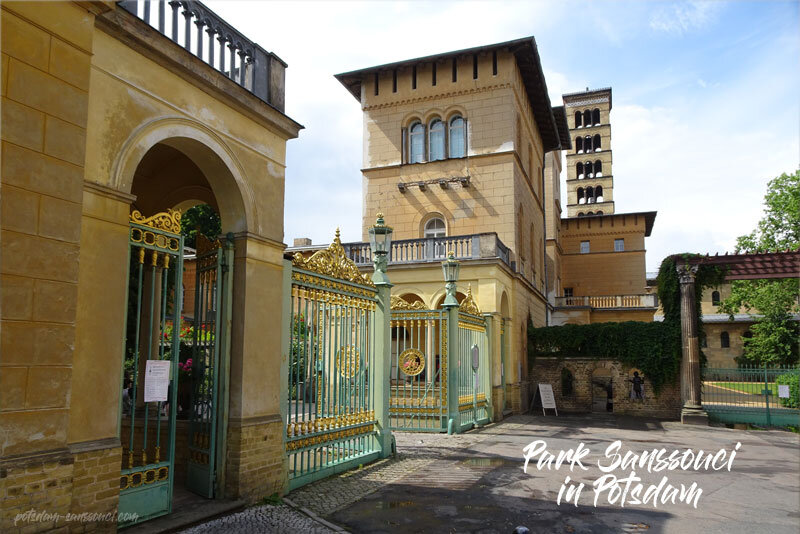
Sanssouci Park , with its approximately 290 hectares of park area and its many palaces and buildings of different styles, is one of the most beautiful park landscapes in Germany and a real visitor magnet. It is one of the top sights in Potsdam. This is precisely why many visitors come to Potsdam – to visit Sanssouci. We would like to introduce you to the park and the sights and give you some information.
| The Sanssouci+ ticket is valid for 11 castles
|
Tip: Explore Potsdam & Berlin with the Berlin WelcomeCard for 48h, 72h, 4, 5 or 6 days. Use public transport in zones AB or ABC, get discounts of up to 50% from over 200 partners (including many Potsdam institutions such as Sanssouci Palace) & use the pocket guide.
Table of contents
Creation of architecture and garden art in Sanssouci Park
The Sanssouci Palace Park (French: sans souci = without worry) is a creation of architecture and gardening and is considered the work of Frederick II, King of Prussia. It was he who had the park built and designed from 1744. The park did not develop overnight, but over 250 years. Different garden artists were involved in the construction, expansion and redesign of the park. These included Georg Wenzeslaus von Knobelsdorff, Heinrich Christian Eckstein, Peter Joseph Lenné and Gottlob Schulze. The park has been a UNESCO World Heritage site since 1990.
History of Sanssouci Park
Beginning in 1744, Frederick the Great had Sanssouci Palace and the surrounding grounds of the eastern park built. Frederick already knew many castles and parks, studied books and plans. It is remarkable that he made his own sketches for many buildings. He also liked to be inspired from other countries and adopted ideas and suggestions for park design.
Frederican pleasure garden
The centerpiece is, on the one hand, the Frederician pleasure garden, which is regular to the west of the obelisk. This was built between 1744-57. The vineyard terraces northwest of the Marlygarten also form the centerpiece. The Marlygarten was also the old kitchen garden of his late father Frederick Wilhelm I .. From the vineyard on which he had Sanssouci Palace built, Frederick was able to enjoy a wonderful view of Potsdam and the surrounding area. That is why he had a tomb created in the vineyard in which he wanted to be buried.
Sentimental-landscape deer garden
The sentimental landscape rehabilitation garden to the west was created between 1745 and 1763. Here he had the old pheasant and roe deer planted and sculptures erected. This leads to the New Palace and around the Belvedere on the Klausberg.
Extensions and modernizations
The first landscape modernizations took place in 1787 and 1822. In 1826 and 1827, the park was expanded with the Charlottenhof Park and in 1827/28 with the new facilities (hop garden). There were further changes to the park after 1840, when the Frederician parts of the garden were changed and the Marly Garden was redesigned in a landscape style (1845-1847). The historicist Sicilian and Nordic Gardens were created as part of the Triumphstrasse planning. The gardens around the orangery were also created between 1853-70. Between the years 1902 and 1908 the park was rounded off by the so-called Potente piece (inspired by the Nordic landscapes). The last changes took place in 1913 with the Maulbeerallee with the Jubilee Terrace.
Frederick the Great created a water reservoir on the nearby Höneberg to irrigate the park and the many fountains. Today the mountain is called the ruin mountain.
Numerous sights and castles
In addition to the park and Sanssouci Palace, there are countless other sights in the park. Examples include the New Palace, the Orangery, and the Chinese tea house in Sanssouci Park.
- Sanssouci Palace
- New Palace
- Orangery
- Chinese tea house
- Charlottenhof Palace
- Church of Peace
- Picture Gallery of Sanssouci
Sanssouci Palace
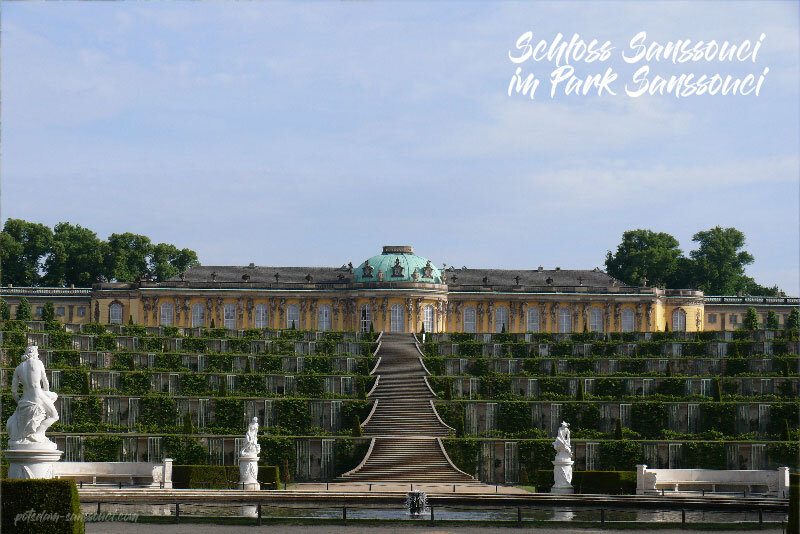
Sanssouci Palace is the highlight of every Potsdam trip. Let yourself be enchanted by the summer palace of Frederick II and the vineyard terraces.
New palace
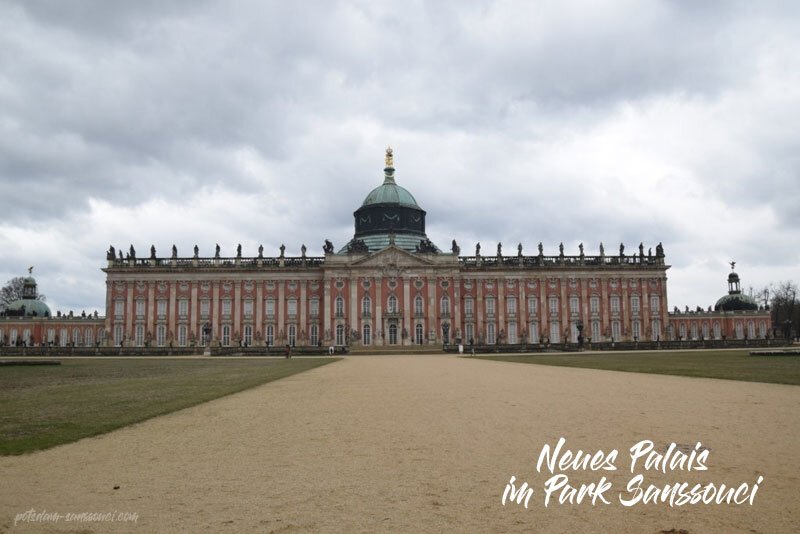
Frederick’s last creation – the New Palace – the Fanfaronade, was built between 1763 and 1769 to mark the end of the Prussian Seven Years’ War. Builder for Frederick the Great included Büring, Manger and Gontard. The beautiful Rococo building stands in the west and forms the end of the park.
Orangery palace
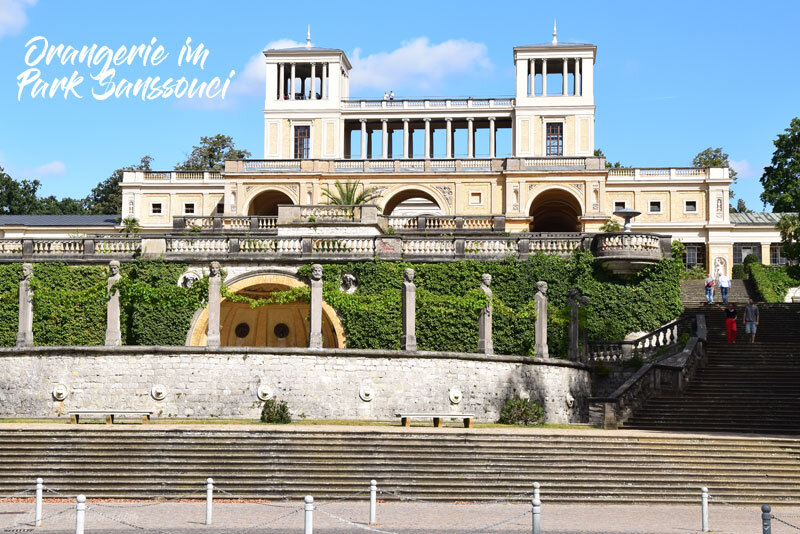
The orangery palace was built by Persius on behalf of Frederick Wilhelm IV. From 1851 to 1860. The Italian Renaissance is reflected in the 300 meter long building.
Chinese tea house
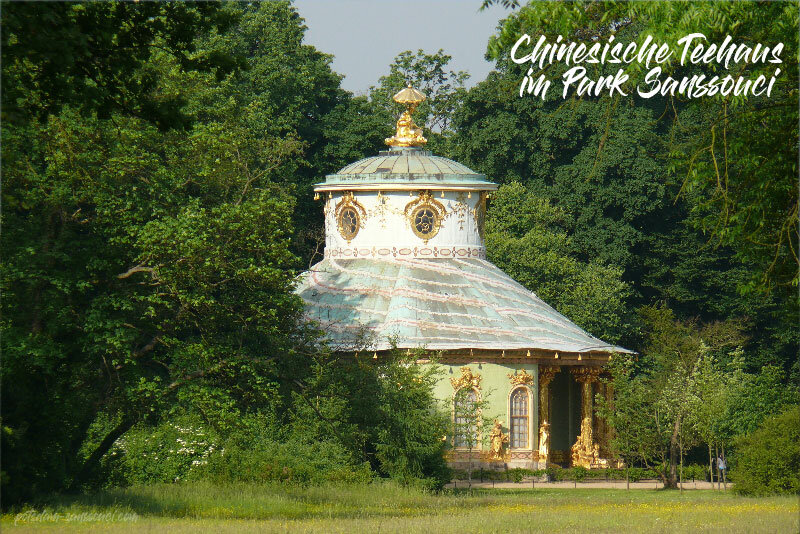
Frederick the Great had the small Chinese pavilion built near his summer palace Sanssouci. Around the Chinese tea house are life-size, gilded sandstone figures of musicians and Chinese dining.
Charlottenhof Palace
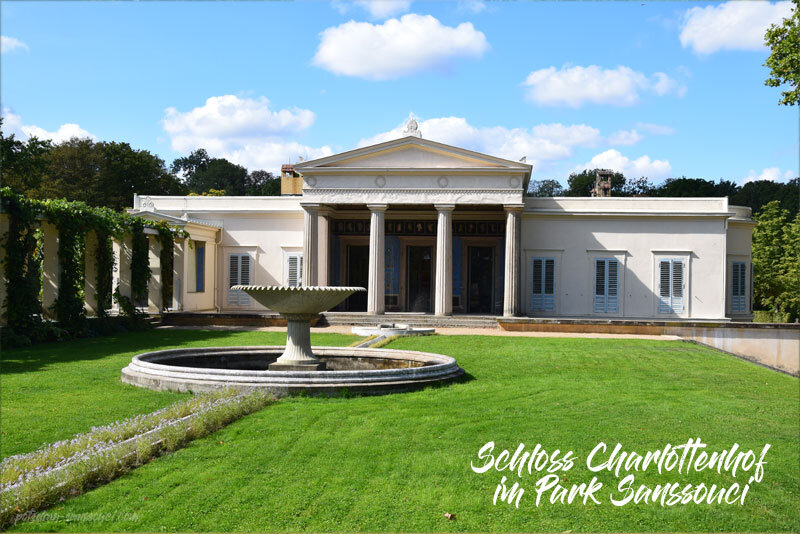
The Charlottenhof Palace, modeled on Italian country villas, is a classicist summer palace. It belonged to Crown Prince Frederick Wilhelm IV and his wife Elisabeth. It was originally built by Johann Gottfried Büring from 1756 to 1758. Later, from 1826 to 1826, it was transformed into a castle by Karl Frederick Schinkel and Ludwig Persius.
More Attractions
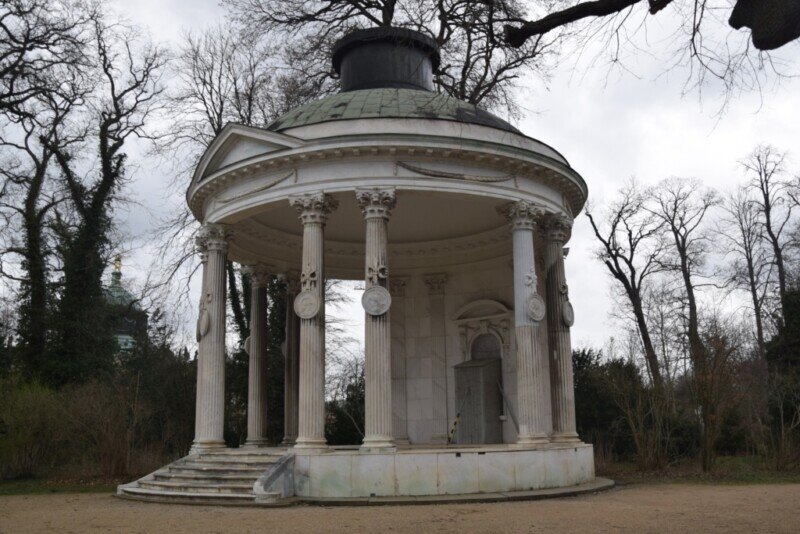
Friendship Temple in Sanssouci Park
The Friendship Temple is a small round temple in the western part of the park in Potsdam, near the New Palace. It was built by the Prussian King Frederick II in memory of his favorite sister, Margravine Wilhelmine von Bayreuth, who died in 1758. Between 1768 and 1770, Carl von Gontard created the pavilion near the New Palace, south of the main avenue, as a counterpart to the Temple of Antiquity, which was located in an axis north of the avenue.
Antiquity Temple in Sanssouci Park
The Antikentempel is a small round temple in the western part of Sanssouci Park in Potsdam. Frederick the Great had the building built to keep his collection of ancient art objects, coins and gems. In 1768/69, Carl von Gontard created the building near the New Palace, north of the main avenue. It can be seen as a counterpart to the friendship temple built in an axis south of the avenue. From 1921 the antique temple was used as a mausoleum for members of the Hohenzollern family. For this reason it is no longer accessible to the public.
Potsdam Castle Night in Sanssouci Park
Once a year the Potsdam Castle Night (“Potsdamer Schlössernacht”) gives the park a special atmosphere. Impressive lighting of the numerous palaces and buildings in the park allows you to explore the park from different angles. If you would like to take part, you can find information on the Potsdam Castle Night and the purchase of Castle Night Tickets in the linked article.
Address of the Park Sanssouci
Zur Historischen Mühle 1, 14469 Potsdam
You can find information on opening times, admission prices and contact options here.
Guided tours and tickets
| The Sanssouci+ ticket is valid for 11 castles, including the New Palace
|
| About this activity | Book now / informations |
|---|---|
| Tickets | |
combination ticket sanssouci+ The combination ticket sanssouci+ allows for a one-time visit to all* open palaces of the Prussian Palaces and Gardens Foundation Berlin-Brandenburg in Potsdam, including Sanssouci Palace, on a single day. (Starting from €17 per person, GetYourGuide, free cancellation up to 24 hours before the start.) | |
Potsdam: Sanssouci Palace Guided Tour from Berlin  Experience the gardens and majestic architecture of the Sanssouci Park on this tour from Berlin. Explore the highlights of Potsdam, the Sanssouci's palace, and the beautiful Peace Church. (From € 54 per person, GetYourGuide)) Experience the gardens and majestic architecture of the Sanssouci Park on this tour from Berlin. Explore the highlights of Potsdam, the Sanssouci's palace, and the beautiful Peace Church. (From € 54 per person, GetYourGuide)) | |
| Guide Tours | |
Berlin: Potsdam - Kings, Gardens & Palaces 6-Hour Tour Explore the city of Potsdam with a English-speaking guide on a half-day tour of its picturesque palaces, lakes and gardens. Steeped in history, from Frederick the Great to Churchill, Truman and Stalin, you will take a trip back in time. (From 28,90 € per Person, GetYourGuide) | |
Potsdam: Private Sanssouci Palace Walking Tour Visit Potsdam on a private walking tour through the over 1,000-year-old city center and stroll through the manicured gardens of the historical Sanssouci Palace. (From € 195 per group up to 30, GetYourGuide). | |
From Berlin: Potsdam & Sanssouci City of German Kings Tour Explore one of the most beautiful and interesting places in Germany, Sanssouci, with its large palaces and gardens. Hear the fascinating story of how Germany and Prussia came into being. Appreciate the architecture as your guide takes you around Potsdam. (From € 290 per group up to 6, GetYourGuide) | |
From Berlin: Potsdam Private Guided Tour in English Explore the former royal residence of the Prussian kings on a private 6-hour tour of Potsdam from Berlin. See the UNESCO World Heritage palaces and parks, and learn the city’s history from your guide. Go to the Marble Palace, Schloss Cecilienhof, and more. (From € 960 per group up to 6, GetYourGuide) | |
Gardens & Palaces of Potsdam Bike Tour from Berlin Potsdam is Berlin’s most popular destination for day trips and a playground for a bicyclist, with many Prussian and Cold War sights tucked deep in verdant parks and along quiet alleyways. On this 6.5-hour tour from Berlin, explore Potsdam’s many sights. (From € 75 per person, GetYourGuide) | |
From Berlin: Potsdam city tour of the emperors The former capital of the Kingdom of Prussia, Potsdam's baroque parks and palaces, have received the status of a UNESCO World Heritage Site. Explore the city with a guide on this small-group tour by train from Berlin. Hear about emperors, kings, and World War II. Stroll through ornate streets and Sanssouci Park. and skip the long lines for Sanssouci Palace itself. Please note: Entrance fees and train tickets are at your own expense. (from € 50.00, Viator) | |
Private half-day walking tour of Potsdam and Sanssouci Palace Explore the former seat of the Prussian kings on this private half-day tour of Potsdam, including the magnificent Sanssouci Palace. Follow your guide through Potsdam's old town, stopping to snap photos of the Brandenburg Gate. Stroll through the opulent City Palace and admire the red brick buildings of the Dutch Quarter. Then admire the UNESCO World Heritage Site Sanssouci Palace and explore the palace gardens, the Chinese tea house, and the tomb of the Prussian King Frederick the Great. (from € 190.00 per group (up to 10), Viator) | |
Berlin: Sachsenhausen Concentration Camp and Potsdam Tour Discover two of the most iconic sights of the Berlin area on the only tour with transport included. Take a guided tour of the Sachsenhausen Memorial and enjoy a tour of the historic city of Potsdam. (From € 49 per person, GetYourGuide, Reserve now and pay later to book your spot and pay nothing today) | |
Potsdam: Sanssouci Park Self-Guided Gardens Audio Tour Find out what made Potsdam’s Little Versaille so special to several former kings on this self-guided audio tour. Walk around the garden's landmarks and experience the magic of GPS playback. (From 5,43 € per person) | |
| Sightseeing Tours & Boat Cruises | |
Potsdam: City and Castles Tour  Enjoy a fun city tour of the highlights of Potsdam and visit the fascinating castles of Sanssouci, Cecilienhof and the New Palace. Stroll through the Baroque old town and walk in the footsteps of "Old Fritz". (From € 25 per person, GetYourGuide, Bestseller) Enjoy a fun city tour of the highlights of Potsdam and visit the fascinating castles of Sanssouci, Cecilienhof and the New Palace. Stroll through the Baroque old town and walk in the footsteps of "Old Fritz". (From € 25 per person, GetYourGuide, Bestseller) | |
Potsdam: 1-day ticket for the hop-on / hop-off bus tour  Discover Potsdam at your own pace with a 1-day ticket for the hop-on and hop-off sightseeing bus tour. Get live commentary as the bus travels past the main sights and attractions, and jump off at any of the 12 stops. (From € 20 per person, GetYourGuide) Discover Potsdam at your own pace with a 1-day ticket for the hop-on and hop-off sightseeing bus tour. Get live commentary as the bus travels past the main sights and attractions, and jump off at any of the 12 stops. (From € 20 per person, GetYourGuide) | |
Potsdam: Palace Tour by Boat  See the most beautiful sights of Potsdam and discover the hill landscape from the water in only 90 minutes. Admire the countless palaces and wonderful parks from the Hohenzollern Dynasty and see a true piece of history. (From € 22 per person, GetYourGuide) See the most beautiful sights of Potsdam and discover the hill landscape from the water in only 90 minutes. Admire the countless palaces and wonderful parks from the Hohenzollern Dynasty and see a true piece of history. (From € 22 per person, GetYourGuide) | |
Potsdam by Boat: Island Cruise  Discover all of Potsdam on this very special boat trip and explore the unique riverscape surrounded by impressive manor houses and magnificent buildings. Admire Caputh Castle, Babelsberg Castle and other beautiful sights. (From € 36 per person, GetYourGuide) Discover all of Potsdam on this very special boat trip and explore the unique riverscape surrounded by impressive manor houses and magnificent buildings. Admire Caputh Castle, Babelsberg Castle and other beautiful sights. (From € 36 per person, GetYourGuide) | |
| Events | |
Potsdamer Schlössernacht in Sanssouci Park ++ Potsdamer Schlössernacht ++ One of the special highlights is the Potsdamer Schlössernacht in Sanssouci Park in Potsdam. The annual two-day event attracts thousands of visitors to Potsdam every year. Tickets are now available from Eventim. | |
| City Cards | |
Potsdam & Berlin WelcomeCard:   Explore Berlin with a 2, 3, 4, 5, or 6-day Berlin WelcomeCard. Ride public transport in the ABC zones, including Berlin Brandenburg Airport, receive discounts of up to 50% with many partners, and benefit from the pocket travel guide. (From € 24 per person, GetYourGuide) Explore Berlin with a 2, 3, 4, 5, or 6-day Berlin WelcomeCard. Ride public transport in the ABC zones, including Berlin Brandenburg Airport, receive discounts of up to 50% with many partners, and benefit from the pocket travel guide. (From € 24 per person, GetYourGuide) | |
| Tip: With GetYourGuide you can cancel booked activities up to 24 hours before the start and receive a full refund. | |
| Note: Avoid purchasing tickets on the black market. Our ticket partners are exclusively verified vendors. | |
You can find official information on the website of the Prussian Palaces and Gardens Berlin-Brandenburg Foundation.









